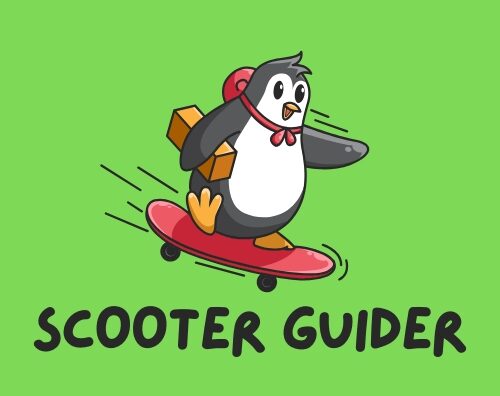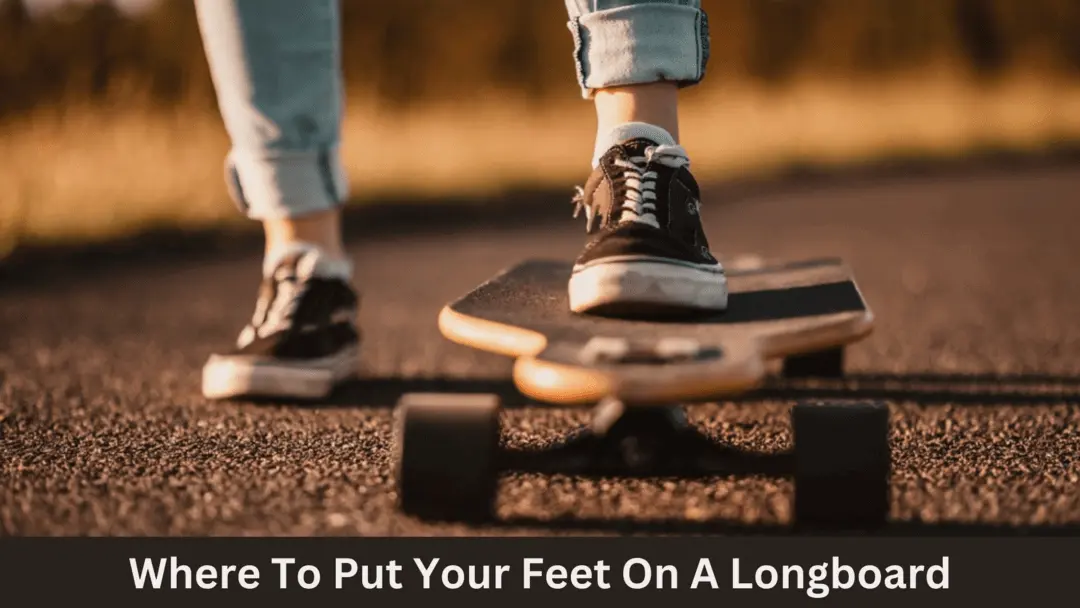How does riding a longboard feel when rolling or cruising? Flying? Or running? Whatever it is! On the longboard, we enjoy skating. But occasionally, due to some mistakes, we miss some tricky or simple tactics. We found it difficult to put our feet in the right positions. So, we need to know what a longboard stance is.
Stances are how you position the rest of your body while riding a longboard, in addition to how you put your feet on the board. Incorrect foot position is frequently the cause of disturbances or injuries.
This article will clarify Where to Put Your Feet On a Longboard as a result, enabling you to make the ideal move when riding your longboard. In order to make stand-up flips easier, better controllable, and faster, let’s learn how to arrange your feet appropriately and a few typical longboard stances that you must know when riding.
What is Longboard Stance?
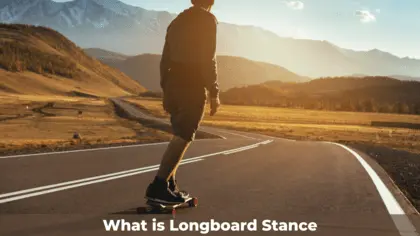
When riding a longboard, your body position and how your feet are positioned on the board are both referred to as your “longboard stance.” Alternatively, your posture while using a longboard is a stance.
- Your longboard stance is also influenced by where you place your feet, how your shoulders and hips are positioned, how far your knees bend, and how your body leans.
- When longboarding, positioning your body and upper extremities is equally important.
- Consider how you are riding attentively rather than just concentrating on which foot or hand is dominant. Your stance is dictated by both your body and brain.
- Being left-handed or right-handed isn’t everything. It’s about proper positioning.
Types of Longboard Stance
When riding, we often use one of two positions. The two different ways to stand on the board are in a normal position and a silly position. We also use the natural, switch, fakie, or nollie stances as foot placement.
- When beginning to longboard, the natural stance is the most comfortable position to take.
- The regular longboarding stance is when you stand with your right foot at the back of the longboard and your left foot in the front. When you ride a skateboard in your normal stance but in reverse motion, you are in the fakie stance.
- A goofy stance is when your right foot is the front foot and your left foot is the back foot of the longboard.
- While the nollie stance is similar to the natural stance, it differs in that both of your feet are moved toward the front of the skateboard.
- Because it forces you to ride in your natural opposite posture, the switch stance can be difficult for beginners and intermediate skaters.
Foot Placement Ideas
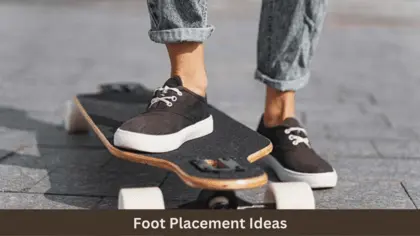
When riding, one foot leads the other, and your torso is positioned perpendicular to the longboard’s movements. Footedness, the foot counterpart of becoming right-handed or left-handed, is the natural preference of your left or right foot.
While your front foot is what provides your longboard control and efficiency, your back foot does the rest of the turning. You want your dominant foot to be in the back. The opposite foot balances and guides you directly ahead. Since the right foot is frequently dominant and is controlled by the left brain, most people feel more at ease moving their left foot forward and right foot back.
Choosing The Footing
Put all of your weight on the front foot. Then, place your back foot on the board. Ensure that your back foot is at a 90-degree angle. When riding normally, place your feet wider than shoulder-width apart, with nearly comparable distances between your front and rear tires.
Selecting the Proper Foot
Typically, we try both serious and silly poses. These two postures are based on the foot you usually use for stability and power.
Understanding this is crucial because the majority of the moving is done with your prominent foot, which is inserted into the back of the longboard. Your strong feet would allow you to maintain a precise board direction.
You can start by kicking or moving a ball. Another technique is allowing your friend to nudge you.
You Should Know Your Front Foot
You need to place your front foot on the foot that exerts less force. Grab the board’s front edge with this foot. A 45-degree angle is required for positioning. The foot should be positioned near the back screws of the board. It should exert the greatest force there. Create an angle of perpendicularity between this foot and the deck.
Feet Distance is Required
Keep your feet at a distance from the ideal balance. They’re about shoulder-width apart. It’s important as you need to maintain a good balance. Having close feet can make you suffer from maintaining balance.
Which Foot Should You Push With When Skating?
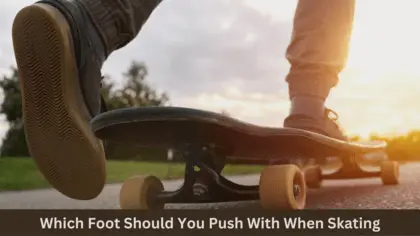
Your rear foot should push off while your front foot stays on the board, and that’s quite normal. Regular riding is a way of pushing your board with your right foot while skating with your left foot as your front foot. Where the goofy or unusual footers press with their left foot and skate with their right foot in front of the board. Choose the one that best suits your comfort level.
Longboard Sliding Position
Another essential skill to master is sliding foot placement. It’s about toe-side standing. There are so many different sliding approaches, such as the heel-side stand-up slide, push stance, toe-side or heel-side carving stance, real sliding stance, and standard riding stance. Your feet are perfectly positioned on your deck, nearly perpendicular and further apart than the width of your shoulder.
Plant Foot
Your front foot needs to be pointed in the direction of the front of the longboard as you push. Your foot will be roughly 3⁄4 of the way parallel to the longboard’s length. Your foot should be directly in the center or spine of the longboard, allowing you to turn it when you swivel your ankle or shift your weight to the left and right.
From the parallel position down the longboard’s spine, you will move that front foot to an angle of 45 to 90 degrees while cruising. When you’re ready to begin pushing once more, you can move your front foot slightly into the parallel position and do so.
Longboard Cruise Position
All you need to keep your balance when cruising is a small flex in your knees. In order to properly balance, your front foot should be perpendicular to the board, and your back foot should be at an angle of 45 to 90 degrees. When riding, you should place your feet somewhat wider than shoulder-width apart, and the distance should be equal.
Longboard Pushing Position
Most people find it more natural to push with their back foot. Maintain your balance and lower your body on the toes of your foot for your longboard stance and plant, and point it straight forward. Usually, riders balance on their front foot and turn with it while pushing with their dominant foot.
Standing backward is another trick. While your front foot pushes the ground, you balance on the back foot that is located close to the back of the truck. A big toe rotating in one direction may cause the slightest pressure difference. Or you’ll begin to move in that way.
Foot Braking Position
This position idea is almost the same as the pushing stance. It’s about standing on your front leg and pointing your foot in the direction of your nose. Your upper body moves forward, and you take a light stoop to bring your back foot parallel or slightly in front of your standing foot to the ground.
The foot braking position indicates that instead of kicking the ground when pushing, you brush against it with your middle and back heels while lifting the toes.
Longboard Carving Stance
The carving posture is a lifesaver when stopping a rolling longboard from going down a hill, even though rolling might seem to be good. No matter whether you lose or gain velocity, carving involves spinning around turns.
Both feet must be positioned in a straight line with your board when you are in this posture. The stance will be greatly affected by knee bending and curling as well.
Excellent for both cruising and carving, the Drop Cat is a wonderful board. The carving is actually a pretty wonderful idea to slow oneself down, especially in the event that you begin to sway.
Longboard Speed Stance
You must master a specific position that we call tuck for speed riding. You need to position your body in a way that reduces wind resistance and increases stability when moving quickly. Your front foot is positioned in a tuck stance close to your front truck mount at a 15-30 degree angle with the deck.
You are standing with your rear foot approximately a foot’s length behind your front foot, which is parallel to it, and sitting on its toes. To make the front spin, your toes should be close to the board’s edge.
Freestyle Longboard stance
Freestyle longboarding is the most adventurous way to ride a longboard, which involves many flips and spins. You proceed by placing your front foot on the nose of your board and your back foot in the middle of the deck. You can also try the back foot on your rear kick tail and begin other techniques.
Related longboard riding: How do I make my longboard ride smoother?
Some Proper Foot Positioning Tips
- Hold tape that is very strong. Your feet will be considerably better stabilized on the board.
- Choose a lovely deep concave to keep your feet firmly attached during sliding.
- Try to maintain a distance of 1.5 to 3 cm from the bolts.
- An angle of about 45 degrees should be made with your foot.
- The technique for making quick adjustments between heel and toe side checks is to maintain the feet in the same posture and simply change your weight from your heels to the toes.
FAQ
1. Where should feet be on a longboard?
On the deck, the feet are often positioned symmetrically, perpendicularly, and somewhat wider than shoulder-width apart. Either you go for a standard or goofy riding posture.
2. Which way to put your feet properly on a longboard?
At regular speeds, you can spin, slide, and balance. We recommend a shoulder width of horizontally plus or minus one or two inches in a riding position for both feet on the board. Your lead foot, right foot, or goofy stance can be great for longboarding.
3. Is it OK to push with your front foot on a skateboard?
Yes, it’s completely fine. Some skateboarders try pushing Mongo, but if you want to learn professional flip stunts, learn more tricky pushes.
4. Do you push with your front or back foot on a longboard?
On a longboard, the pivot foot controls the board while your back foot does the majority of the movement. If you choose, you can position your dominant foot at the back while the other foot balances and directs you forward.
Conclusion
Let’s conclude the entire section of Where to Put Your Feet on a Longboard. We have discussed all the foot positions and stance ideas. Hope you understand where to position your feet and how to make a skillful ride.
You may successfully complete every stance you wish to attempt, including riding, pushing, smooth carving, and speed boarding, by paying attention to the foot positions we’ve provided. However, avoid being obsessive about mastering difficult techniques asap. Keep practicing to develop all the skills to become a professional longboarder.
